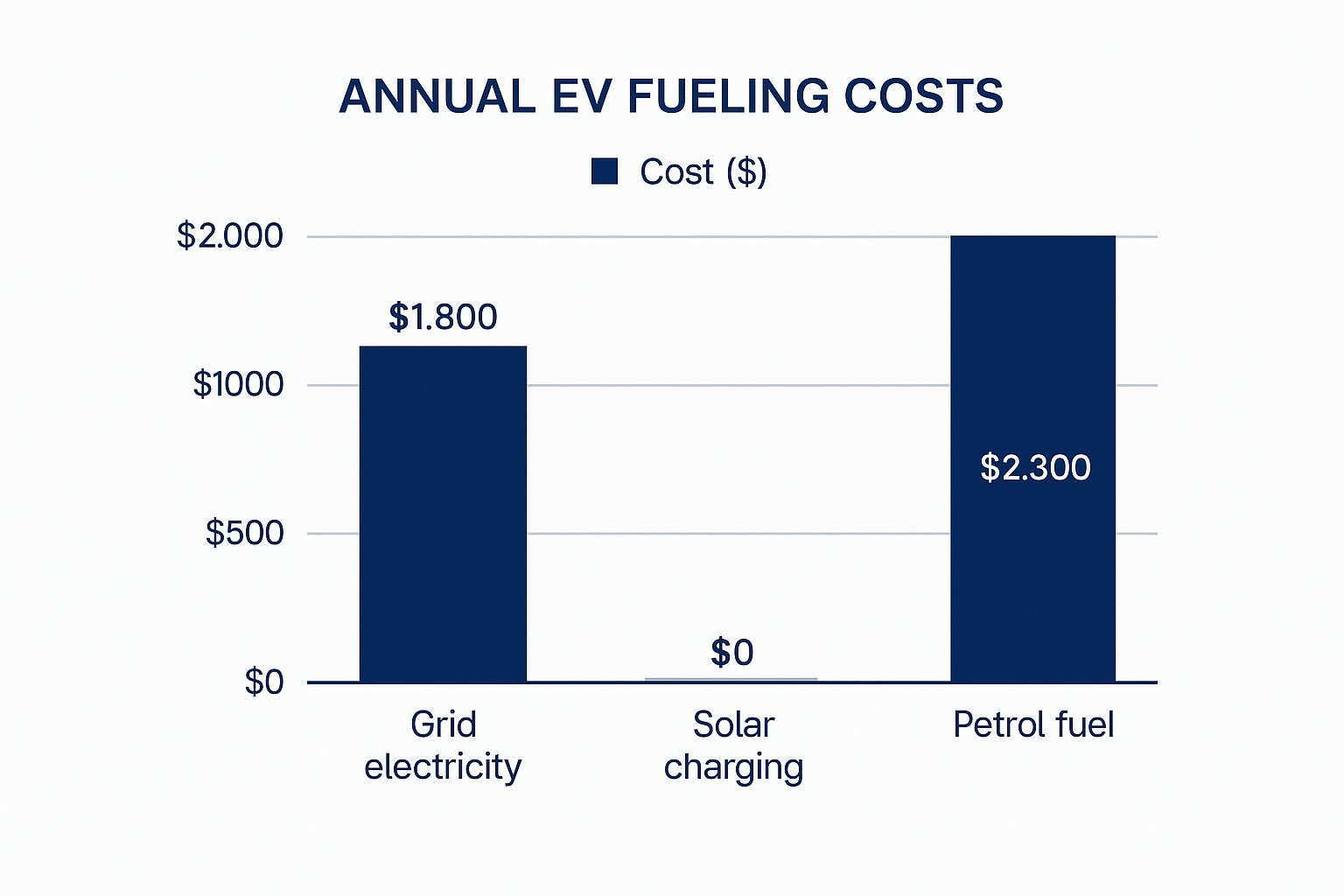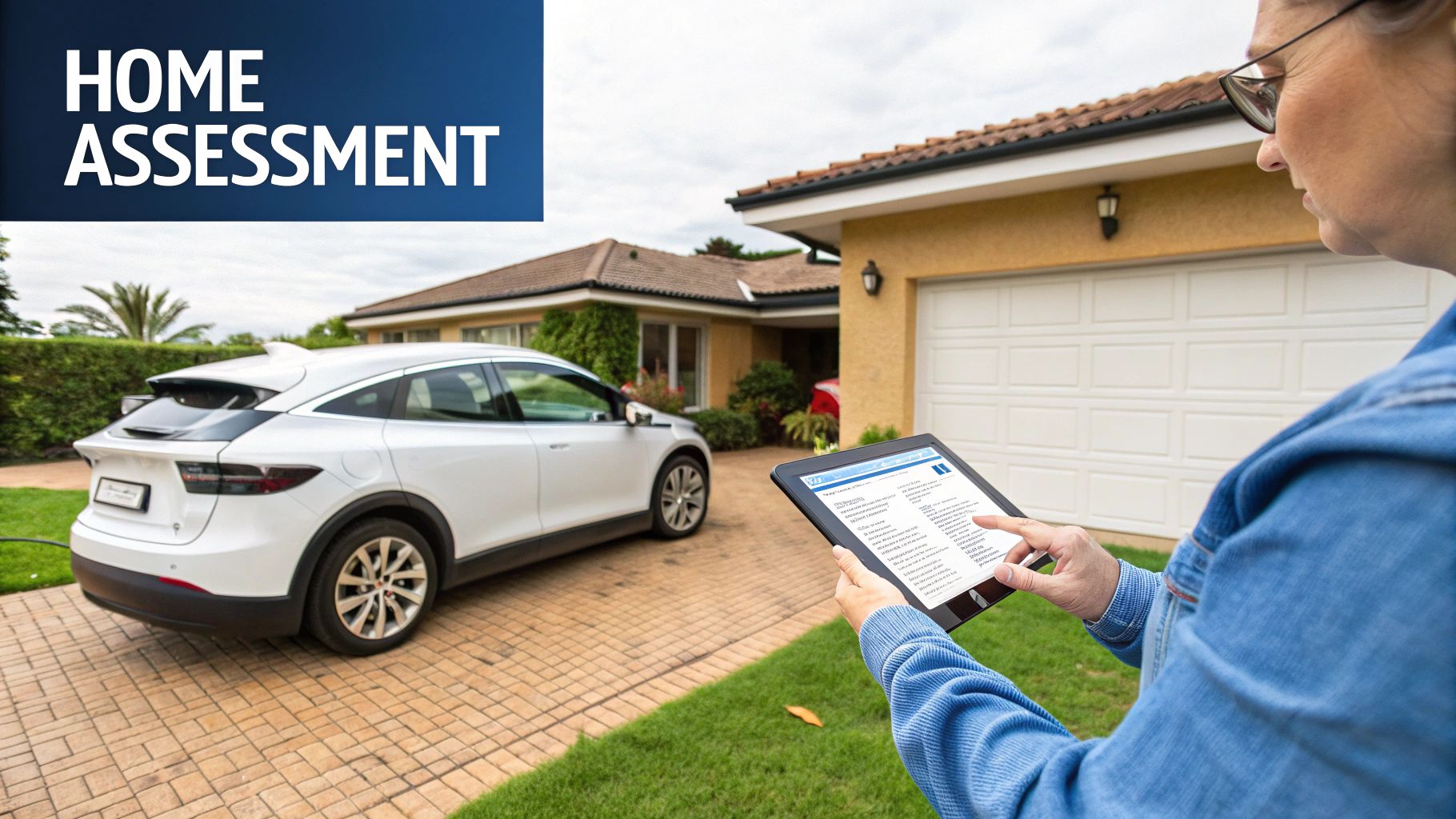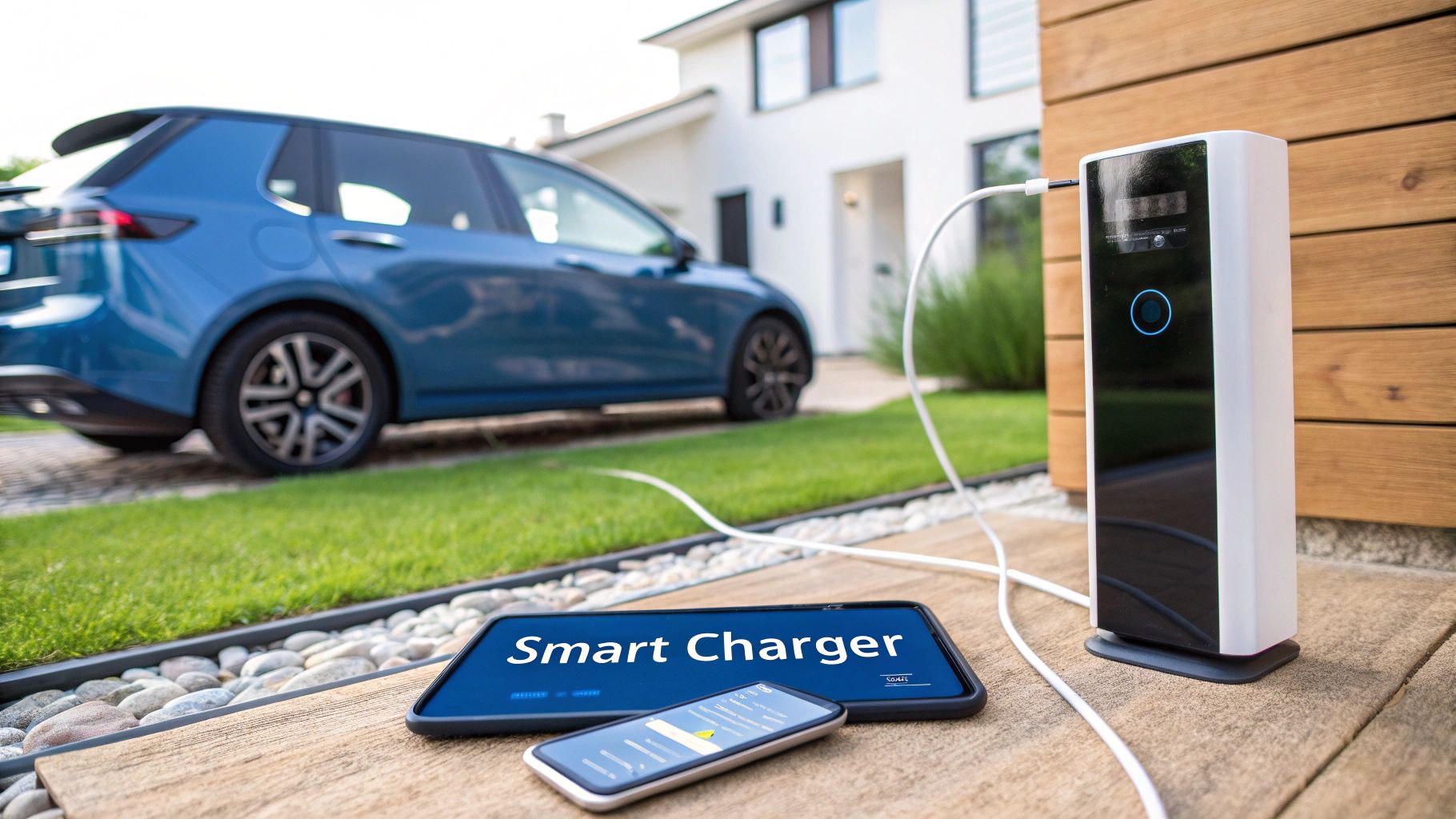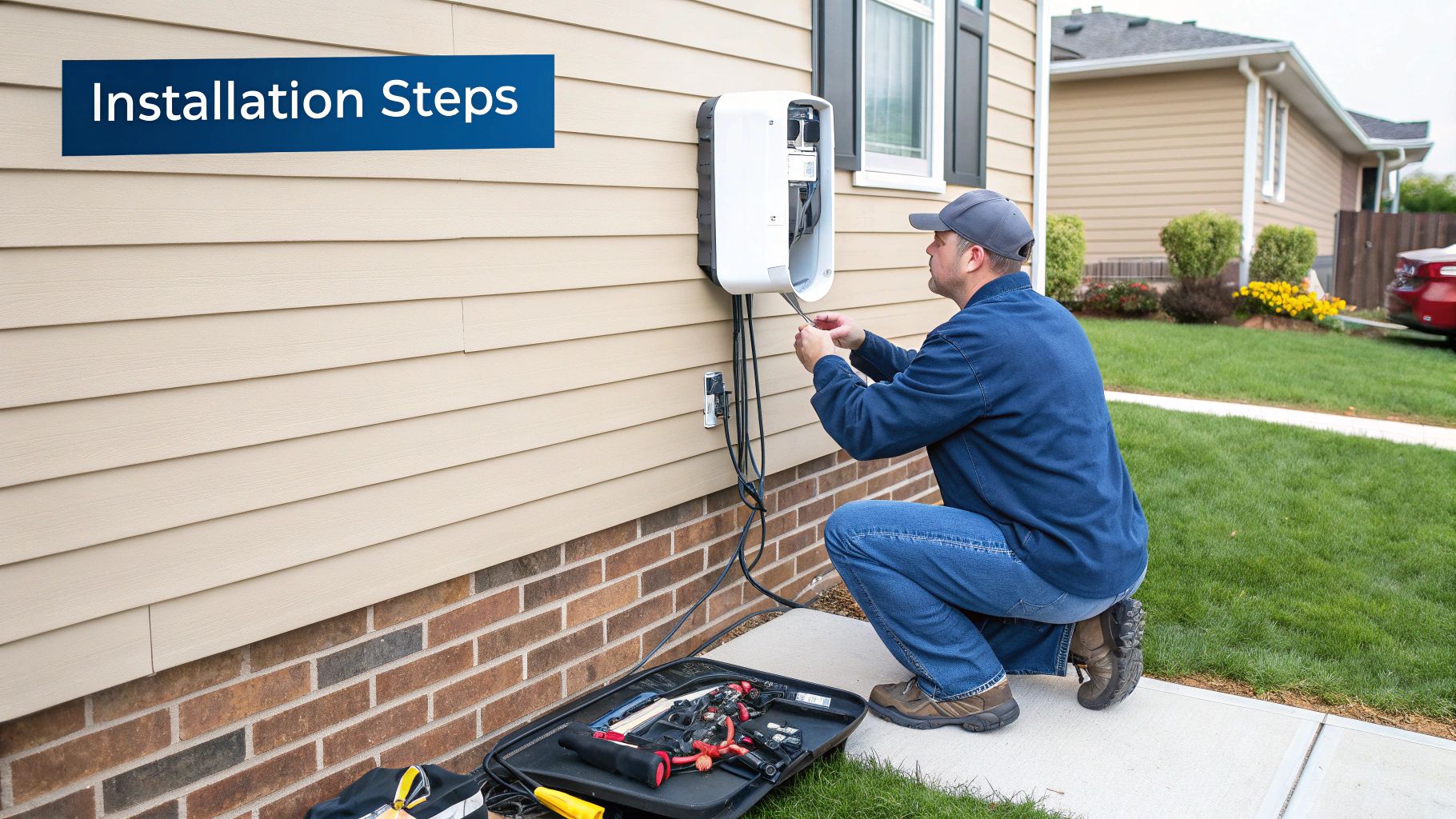Your Guide to Solar Electric Car Chargers in Australia
A solar electric car charger is exactly what it sounds like: a smart piece of kit that uses the energy from your rooftop panels to power up your electric vehicle. Often for free.
It’s a simple combination of two powerful technologies, letting you quite literally drive on pure sunshine. For your household, it’s a huge step towards slashing your carbon footprint and taking control of your running costs.
Why Charging Your EV with Solar Is a Game Changer
Picture this: your daily commute is powered without a single trip to the petrol station. No more worrying about fluctuating grid prices. This is the new normal for thousands of Aussie homeowners who’ve paired their electric vehicles with rooftop solar.
While the green credentials are obvious, it's the financial and practical perks that really make this setup a game changer for managing your home's energy.
A solar EV charger unlocks a new level of energy independence. Instead of sending your spare solar energy back to the grid for a pittance of a feed-in tariff, you can steer that clean, free electricity straight into your car's battery. You're effectively fuelling your car with an asset you already own, squeezing every last drop of value from your solar investment.
Slashing Your Fuel Budget to Zero
Let's get practical. A typical Australian family drives about 40 kilometres a day. On petrol, that can easily cost over $2,300 a year. Even charging from the grid at home, you're still looking at around $1,800 annually.
Charge up with solar during the day, and that cost drops to zero.
This chart paints a pretty clear picture of the difference in annual fuelling costs.

As you can see, fuelling your car with solar completely wipes out a major household expense, leaving a lot more cash in your pocket over the long run.
Future-Proofing Your Home Energy
This move towards self-sufficiency is only becoming more important. The Australian EV charging market was valued at around US$250.5 million in 2024 and is set to grow at a blistering pace. It shows just how vital charging infrastructure is for Australia’s EV transition and sustainability targets.
By integrating your EV charger with your solar system, you're not just saving money; you're creating a resilient, self-sufficient energy ecosystem at home. You gain control over your energy production and consumption, insulating your family from rising energy costs.
What’s more, the smartest setups can even help stabilise the grid. By connecting to platforms like a virtual power plant in Australia, you can earn money by sharing your stored energy during peak demand. Your car and home effectively become active assets, supporting the grid and earning you credits in the process.
Evaluating Your Home for Solar EV Charging

Before you even start looking at charger models, it pays to take stock of your home's energy setup. Doing this groundwork first ensures your new solar electric car charger is a perfect fit, not a source of frustration and unexpected costs down the track.
Think of it as drawing up an energy blueprint. You need to get a handle on three things: how much power your house already uses, how much your EV is going to need, and what your solar system can realistically deliver. Nail this part, and the rest of the process becomes a whole lot smoother.
Unpacking Your Energy Habits
Your quarterly electricity bill is more than just a number—it’s a data goldmine. Hunt down your average daily consumption in kilowatt-hours (kWh). This is your baseline, the amount of power your home chews through before an EV even enters the picture.
Look for patterns. Does your usage spike in summer when the air conditioner is running flat out? Knowing when your system is already under pressure is key to figuring out the best times to charge your new car.
Calculating Your Driving Needs
Next, let's work out how much extra juice your EV will actually need. This doesn't have to be guesswork. For one typical week, use your car's trip meter to track how many kilometres you really drive each day.
With that daily average, you can make a solid estimate. Most modern EVs use somewhere between 15 to 20 kWh of energy for every 100 kilometres travelled. So, if your daily commute is a 40 km round trip, you're looking at needing an extra 6-8 kWh each day just for the car.
It's easy to overestimate how much you drive. Tracking your actual kilometres for a week gives you a real-world number to work with. This simple step helps you avoid the common trap of oversizing—and overpaying for—your charging setup.
To give you a clearer idea, the table below shows what a typical 40km daily drive looks like for some popular EVs in Australia.
Estimated Daily Energy Needs for Common EV Models
| EV Model | Average Efficiency (kWh/100km) | Energy for 40km Drive (kWh) |
|---|---|---|
| Tesla Model 3 RWD | 13.4 | 5.4 |
| BYD Atto 3 | 16.0 | 6.4 |
| Polestar 2 Standard Range | 17.1 | 6.8 |
| MG4 Excite 51 | 14.5 | 5.8 |
This kind of data gives you a realistic starting point for understanding the new electrical load you're about to add to your home.
Assessing Your Solar System's Output
Finally, it's time to look at your existing solar array. You need two key pieces of information: its total size (in kW) and, more importantly, how much power it actually generates day-to-day. Your inverter's monitoring app is your best friend here.
Check your production data. How does a clear, sunny day compare to an overcast one? The crucial question is whether your system consistently produces more power than your home uses during peak sun hours, typically between 10 am and 3 pm.
This surplus is the free solar energy you'll use to power your car. If you find your current system is already struggling to keep up with your household demand, it might be time to look into adding more high-quality solar panels to make sure you have enough clean energy to go around.
Choosing the Right Solar Electric Car Charger

Once your home’s electricals are ready, it's time to pick the charger itself. This is where a lot of people make a simple mistake. They assume all EV chargers are more or less the same, but when solar is in the picture, that couldn't be further from the truth.
A standard charger just pulls power from the grid. No questions asked. But a true solar electric car charger is smarter. It’s designed to talk to your solar inverter, turning it from a simple appliance into a genuine money-saving tool. Without that intelligence, you're just charging from the grid like everyone else.
What Makes a Charger 'Solar-Aware'?
The magic lies in its ability to see what your home's energy is doing in real time. It knows precisely when your panels are generating more power than the house is using.
Instead of letting that precious surplus spill out to the grid for a pittance, a smart charger grabs it and sends it straight to your EV. This is often called dynamic load balancing, and it’s the heart of solar charging.
When a cloud passes overhead or someone turns on the kettle, the charger instantly adjusts the charging rate. Not a single watt of free, clean energy gets wasted. This all happens automatically, maximising your self-consumption without you lifting a finger.
From an installer’s perspective, the most valuable features are the ones that automate savings. A charger that can intelligently switch between solar, grid, and mixed power sources based on your settings provides the most flexibility and delivers the best long-term value for the homeowner.
Must-Have Modes for Maximum Savings
When you’re comparing models, don’t get lost in the specs. Focus on the charging modes. These are the practical features that give you real control over where your power comes from and when you use it.
- Solar-Only Mode: This is the setting for genuinely free fuel. The charger will only power up your car using 100% surplus solar. It’s perfect for topping up during the day when you aren’t in a rush and guarantees a 100% free charge.
- Boost or Fast Mode: Sometimes you just need to get going. This mode pulls from your solar and the grid simultaneously to charge at the fastest possible speed your home can support.
- Scheduled Charging: This is your tool for playing the energy market. You can set the charger to run in the dead of night to take advantage of cheap off-peak electricity tariffs, ensuring you wake up to a full battery at the lowest possible cost.
The Power of Smart Integration
The best solar chargers are more than just hardware; they come with a powerful mobile app that acts as your energy command centre. A good app won’t just start and stop a charge—it will give you a clear, real-time view of your solar generation, what your house is using, and exactly what’s flowing into your car.
This kind of visibility is incredibly useful. You can tweak schedules, switch modes from anywhere, and actually see your savings add up.
Even better, a seamless connection with platforms like HighFlow Connect lets you be part of Australia’s shift to smarter automotive and mobility energy solutions. Your home becomes a mini power station, helping create a more stable grid for everyone. When choosing, remember the software and connectivity are just as important as the box on the wall.
Navigating the Installation Process

Getting your new solar electric car charger installed and working isn't a weekend DIY project. This is a specialised job that calls for a professional touch. In Australia, that means a licensed electrician, ideally one with Clean Energy Council (CEC) accreditation. These installers are the experts you need to safely hook your charger into both your solar system and your home’s electrical panel.
Bringing in a pro from the get-go helps you sidestep the common headaches. They’ll make sure your setup is not only compliant with all Australian standards but also properly optimised for your home and your energy habits.
What to Expect from a Professional Installation
The whole thing usually kicks off with a detailed site inspection. The sparky will check out your garage or preferred parking spot to figure out the best place for the charger. They’ll also have a good look at your switchboard to see if it can handle the extra load or if it needs an upgrade—a pretty common step for older homes.
From there, the install follows a clear workflow:
- Wiring and Circuitry: A new, dedicated circuit is run from your switchboard straight to the charger’s location. The thickness of this cable is critical; it’s determined by the charger's power rating and how far it is from the board.
- Mounting the Charger: The unit gets securely mounted to the wall. It’ll be at an accessible height and usually placed close to where your EV’s charging port is, to make life easy.
- System Integration: This is the clever bit. For a solar-aware charger, the installer connects it to your solar monitoring system. This is what lets the charger ‘see’ your solar production and ramp its charging speed up or down to match.
- Final Checks and Commissioning: Once it's all wired up, they'll run a series of comprehensive safety tests. The installer then commissions the unit, connects it to your Wi-Fi, and gives you a walkthrough of the app.
A common talking point during the install is where to put the charger. Think practicality. How long is your EV's charging cable? Will the charger be blasted by the afternoon sun or rain? A good installer will help you find the right balance between convenience, safety, and durability.
While home charging is becoming the standard, Australia’s public charging network is also growing at a breakneck pace to keep up. Public fast-charging sites hit 1,310 by mid-2025, an 8.5% jump in just three months, showing just how fast EV adoption is surging. You can find more insights into the rapid growth of Australia's public EV charging network on fleetevnews.com.au.
A standard single-phase charger installation can often be done and dusted in just a few hours, assuming your switchboard is up to the task. More complex jobs, particularly those that need a major electrical upgrade, might take a full day. A good installer will give you a clear timeline and a transparent quote upfront, so there are no surprises on the day.
Unlocking Maximum Savings with Smart Charging Habits
Having a solar electric car charger installed is the first big step, but your daily habits are what truly unlock the savings. It helps to think of your charger not just as a power point, but as a smart tool for managing your home's energy flow. The real win is shifting your mindset from simply plugging in the car to actively choosing when and how it draws power.
The most effective strategy, by far, is to line up your charging schedule with your solar generation. Nearly every modern charger comes with a dedicated app that makes this straightforward. Spend some time in the settings and learn how to tell the charger to prioritise solar. This small tweak ensures your car is drinking up the free, clean energy your rooftop is already making.
Scheduling for Peak Sunshine
In Australia, the golden hours for solar generation are usually between 10 am and 3 pm. If your EV is parked at home during the day, setting a charging schedule inside this window is the easiest path to a zero-cost top-up.
This is perfect if you work from home a few days a week—just make those your primary charging days. A typical top-up for a 40 km daily commute only needs a few hours of decent sunshine, so you don’t even need to be plugged in all day long.
It's about being strategic. Even if you only get two or three 'solar-only' charging sessions a week, you're still dramatically cutting your annual running costs compared to relying on overnight grid charging every time.
Of course, sometimes you just need a fast charge. Don't be afraid to use the grid when you need to. The "Boost" or "Fast Charge" mode in your app is perfect for those times you get home with a low battery and have to head out again soon. It will simply blend solar and grid power to get the job done as quickly as possible.
Creating True Energy Independence
Adding a home battery to your solar and EV charger setup is the final piece of the puzzle. It’s what delivers genuine energy self-sufficiency. A battery acts like a personal power reserve, storing all the excess solar your panels generate during the day.
This lets you do something truly game-changing: charge your EV overnight using the solar energy you captured hours earlier. You become almost completely independent of the grid for your driving needs, filling up with 100% clean energy anytime, day or night.
And while home charging is the most convenient option, it's good to know the public network is growing rapidly. In mid-2024, Australia hosted 1,059 high-power public EV charging locations with 1,849 individual chargers—that's a 90% increase from 2023. These high-power units are crucial for making longer trips possible and crushing range anxiety for good. You can discover more insights about Australia's charging infrastructure expansion on evcandi.com.
By mastering these smart habits—prioritising solar, scheduling for sunshine, and eventually adding a battery—you transform your EV charger from a simple appliance into a powerful financial tool.
Answering Your Solar EV Charging Questions
Even with a solid plan, it’s completely normal to have a few questions before you commit. We get asked these all the time by Australian homeowners, so let’s walk through the common ones to give you the confidence to move forward.
Getting these details right is often what separates a good solar charging setup from a great one.
Can I Still Charge My Electric Car on a Cloudy Day?
Yes, absolutely. Your solar panels are still generating power even when it's overcast, just not at their peak capacity. This is where a smart charger really shows its value.
It automatically senses the lower solar output and dials down the charging speed to match, so you're still using whatever free energy is available. If you're in a rush, the charger will seamlessly blend that solar with a top-up from the grid to get you on your way faster.
How Many Extra Solar Panels Will I Need?
This is the big one, and the answer always depends. But as a solid rule of thumb, for a typical Aussie commute of about 40 kilometres a day, you’ll want to add between 1.5 to 2.5 kW of extra solar capacity.
In real-world terms, that usually means adding another 4 to 6 modern solar panels to your roof. For an exact figure that accounts for your home's location, roof angle, and your specific driving habits, a chat with a CEC-accredited installer is your best bet.
A home battery isn't a mandatory component for a solar EV charger, but it is the ultimate upgrade. It turns your system from a daytime-only charging solution into a 24/7 self-sufficient powerhouse, giving you complete energy independence.
Is a Home Battery Essential for This Setup?
It's not essential, but it is a game-changer. Without a battery, you can only charge with solar power during daylight hours—using the sun’s energy as it’s being made.
Adding a home battery completely changes the equation. It acts like a storage tank, soaking up all the extra solar energy your panels produce during the day. This lets you charge your EV at night, or on a rainy morning, using your own clean, stored power.
What Makes a ‘Solar-Aware’ Charger Different?
A standard EV charger is pretty basic. It just pulls power from the grid, no questions asked. A 'solar-aware' or smart charger, however, is much more clever.
It’s in constant communication with your solar inverter, so it knows exactly what’s happening with your home’s energy in real time. The moment your panels start producing more power than your house is using, the charger diverts that free, surplus electricity straight into your car.
Instead of exporting that power back to the grid for a tiny feed-in tariff, you're using it to fuel your car for free. This one feature is the key to unlocking massive savings.
Ready to take control of your energy and fuel your drive with sunshine? HighFlow Connect can help you integrate a solar electric car charger into a smarter, more resilient home energy system. Learn more at https://highflowconnect.com.au.


